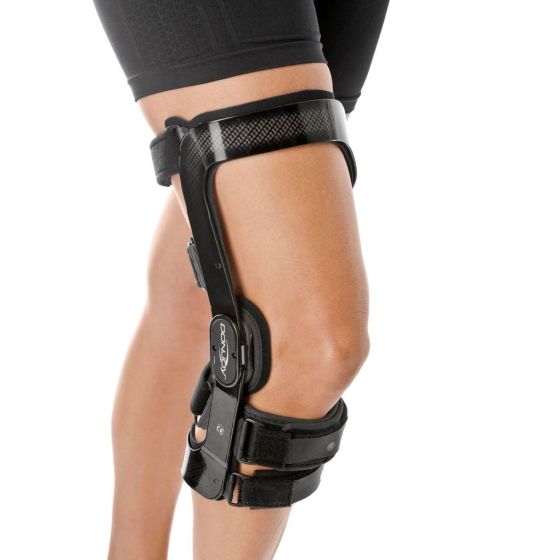OA FullForce Knee Brace
DonJoy
Is the OA FullForce Brace right for me?
Ideal for active individuals recovering from a ligament strain. Try our Brace Advisor for personalized product recommendations to meet your needs!
More Miles, Less Pain
The DonJoy OA FullForce off-loads the affected compartment of the knee while reducing ligament strain.
- 3-Point Off-Loading mechanically shifts the painful joint loads from the degenerative compartment to the healthy compartment, while the hinge allows the ability to fine-tune the load.
- 4-Points-of-Leverage is clinically shown to reduce ACL strain by keeping the knee in a stable position to minimize further cartilage damage.
What is Osteoarthritis (OA)?
Arthritis refers to more than 100 diseases that affect the joints and their surrounding tissues. Osteoarthritis, or OA, is the most common form of arthritis. The statistics on OA are staggering:
- Nearly 21 million people in the United States have OA*
- The incidence of OA is expected to increase even more as the U.S. population ages*
- Over 7 million Americans are limited in their ability to participate in their main daily activities because of their arthritis*
The joint most often affected by osteoarthritis is the knee. Knee OA is caused by the degeneration or breakdown of articular cartilage that covers the ends of the bones that meet at the joint. Cartilage serves as a cushion between the bones, providing a smooth surface for the bones to move against each other. When the cartilage deteriorates the bones may actually be rubbing together. Your physician will often refer to this as “bone-on-bone” osteoarthritis.
*Arthritis Foundation
What is Osteoarthritis (OA) knee bracing and how does it work?
Knee braces are available that are specifically designed to treat OA. They stabilize the joint, help reduce pain and help to build stronger muscles, which allows patients to return to the activities they love. Load redistribution and joint alignment Through a process called “off-loading” or shifting, OA braces helps relieve pain by redistributing the weight bearing load on the painful or affected compartment of the joint to the healthy or unaffected compartment.
What to expect from a Osteoarthritis (OA) knee brace
- Braces cannot cure OA and may not be right for everyone. However, it is a viable solution for many people. The ideal candidates are typically active people who are motivated to strengthen their muscles and willing to wear a brace to realize the benefits of this form of treatment.
- Discuss treatment goals with your doctor and others on your health care team before you get a brace.
- Don’t expect a brace to feel good from the start. It may take from a week to a month to get used to how the brace feels on your leg. Be patient. It took a long time for your knee OA to develop.
Product Questions
1. Grade I injury of lateral collateral ligament
2. Grade II tear of posterior horn of lateral meniscus.
Can you kindly suggest a brace so that i can start playing football please.
waiting for your reply
Regards
Ali
Thank you for contacting product support. DonJoy OA Full Force Knee Brace a great brace for you. It is lightweight and provides stability to the ligaments of the knee and you can get it to off-load the lateral side where your lateral meniscus tear is. If you have any other questions please do not heitate to contact us
Diana
George
Thank you for contacting product support. It is possible that you are not putting the brace on correctly. The middle of the condyle pads should line up with the top of your kneecap. If you followed the sizing instructions on the BetterBraces website and measured six inches above and below the knee cap and took your knee circumference then you should have the correct size. Here is a fitting video that you can use to make sure that you are putting the brace on correctly. https://www.youtube.com/watch?v=ZRB7S2Pj2-A
If the thigh cuff feels too tight it is malleable so you can pull it out a little as well.
Diana
Can you suggest a a good knee brace that will allow me to continue umpiring fast pitch softball which requires squatting and squats to running? I do not want to give it up and my "teams" don't want me to either. Also, do you work with insurance?
The DonJoy FullForce OA brace would be a good choice for you. You would want to get the medial compartment unloader for your knee and it will allow you to still do your umping. To get your insurance to cover this you will need a prescription from your physician and will need to go through either our insurnace department at 800-548-3370 or contact your local DJO sales rep by going to djoglobal.com and looking up a rep http://www.djoglobal.com/contact-us/sales-rep-locator
Take the measurement of your thigh and calf 6" above and below your kneecap using a flexible type tape measure. Use the diameter you measure here to choose your size.
| Size | Thigh | Knee Center | Calf |
| XS | 13" - 15 1/2" | 12"-13" | 10"-12" |
| S | 15 1/2" - 18 1/2" | 13"-14" | 12"-14" |
| M | 18 1/2"- 21" | 14"-15" | 14"-16" |
| L | 21"- 23 1/2" | 15"-17" | 16"-18" |
| XL | 23 1/2" - 26 1/2" | 17"-19" | 18"-20" |
| XXL | 26 1/2" - 29 1/2" | 19"-21" | 20"-22" |
| XXXL | 29 1/2" -32" | 21" -23" | 22" -24 |
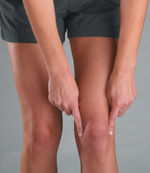 |
1.Stand with your legs shoulder-width apart, legs slightly bent and leg muscles contracted. |
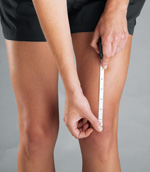 |
2. Measure up six inches from the center of your knee with a tape measure, as shown. |
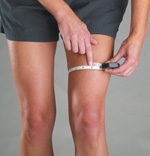 |
3. Measure the circumference of your thigh at the 6-inch mark, as shown. |
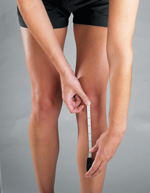 |
4. Measure down six
inches from the center of your knee with
a tape measure, as shown. Then measure
the circumference of your calf at the
6-inch mark.
|





